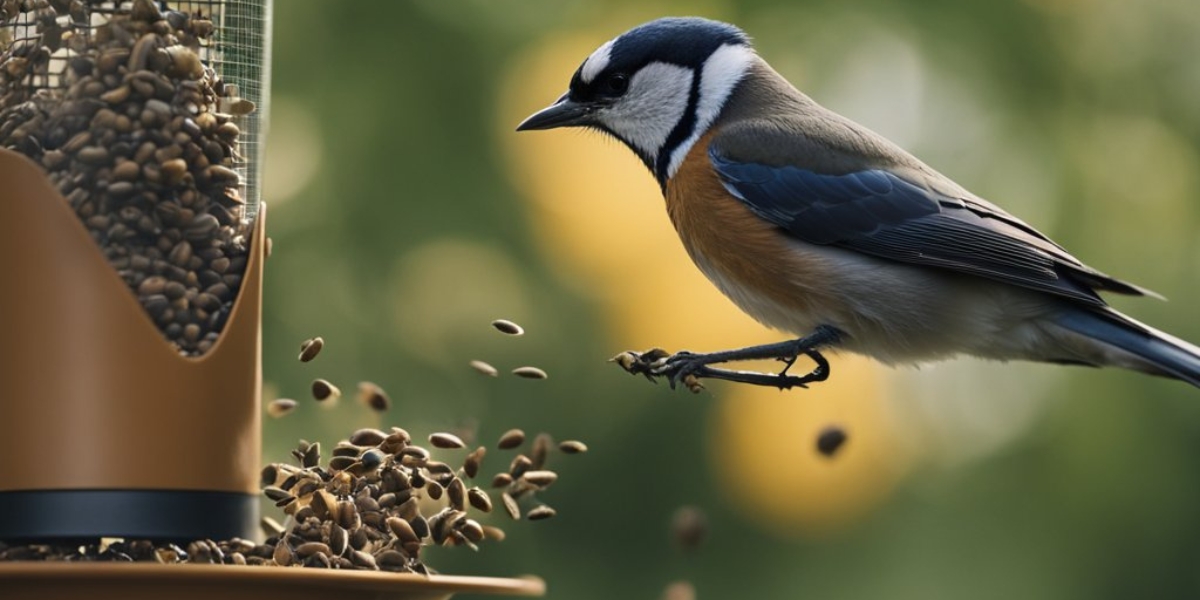One of the frustrations that often arises with backyard bird feeding is food getting wasted. Seed shells litter the ground while uneaten food gets rained on, soiled, or blown away. Not only is this wasteful of our time and money spent keeping feeders full, but piles of rotting, discarded food can be unhealthy for birds.
Luckily, there are ways we can thoughtfully design our feeders and feeding practices to minimize waste and keep the seed from getting wasted. With strategies like wise ingredient choices, tailored feeder styles, smart placements, routine cleaning, and deterring greed, we can fine-tune our bird cafes into waste-reducing paradises.
Read our article on how to stop birds from wasting food so we can make the most of what we offer our feathered visitors.
Choose Bird-Approved Foods
The first step in reducing bird food waste is serving foods your local flocks actually enjoy and will eat. Providing foods they snub leads to maximum dumping. Consider your target bird species and offer:
- Preferred seeds like black-oil sunflower, nyjer, safflower, and white proso millet are based on regional favorites.
- High-quality mixes with limited filler grains are ignored by birds.
- Fresh suet and nectar are changed weekly to avoid spoilage.
- Fruits like orange slices, berries, and raisins were eagerly gulped up.
- Mealworms and peanut butter are nutritious bird candy they can’t resist.
Stick to foods birds crave, and waste will be minimal. Monitor popularity and stop offering consistently rejected ingredients.
Use Tailored Bird Feeders
The style of bird feeder used greatly impacts potential food waste. Select feeders suited to the type of food and species visiting:
- Tube feeders for small, shell-less seeds like Nyjer that would otherwise blow away in open dishes.
- Tray or platform feeders to accommodate larger birds and foods, with drainage to prevent waterlogging,.
- Wide, shallow ground feeders allow ground foragers to easily access seeds.
- Suet feeders to hold cakes firmly and provide woodpecker-friendly tail props.
- Oriole and hummingbird feeders are designed for their unique nectar and fruit feeding habits.
The right feeder reduces dropped and tossed food. Place different styles to attract more species.
Position Feeders in Optimal Spots
Where you place feeders affects potential food waste:
- Near cover and roosting spots so shy birds feel secure accessing them.
- Within eyesight of windows for entertainment.
- Away from predominant winds and rain to avoid food blow outs.
- With a clear flight path for access and escape so birds don’t feel trapped.
- At proper heights and spaces for each species. Chickadees dine higher than doves.
- With perches and ledges for species to pause and eat rather than grabbing food to fly off with.
Ideal feeder placement encourages birds to linger and eat, not madly scatter food about. Observe your patterns and adjust accordingly.
Maintain Cleanliness
Birds are fastidious eaters. Dirty, moldy or contaminated food is a waste magnet. Stop waste with diligent cleaning habits:
- Scrub feeders weekly with soap, water, and vinegar using bottle brushes to reach crevices.
- Sweep and rake up waste below feeders daily to prevent moldy buildup.
- Remove and replace food biweekly, or more in warm weather when spoilage accelerates.
- Wipe nectar feeders with diluted bleach weekly to kill harmful bacteria.
- Rinse fruit offerings to remove grime before serving.
Like we wouldn’t eat from dirty dishes, birds avoiding filthy feeders leads to more waste. A clean, orderly bird cafe mimics birds’ preferences in nature.
Use Tailored Restriction Methods
Some birds are serial food wasters, aggressively tossing aside what they seek. Target these behaviors with tailored restrictions:
- Caged feeders to regulate access and prevent raids.
- Feeders with weighted perches to prevent flying off with mouthfuls.
- Narrow seed portals only large enough for a bill to prevent overzealous beakloads.
- Guards around feeder poles to impede large climbable birds.
- Suet in small recessed cages to force birds to eat slowly rather than pluck and crumble apart a whole cake.
- Multiple small feeders spread out to prevent territorial gorging by dominant birds.
Strategic restrictions that still allow birds to eat their fill CAN reduce greedy waste. Observe and experiment.
Offer Less Food More Frequently
Instead of huge volume dumps inviting frenzied gorging then waste, offer smaller amounts of food more frequently. This regulates usage, encouraging steady measured eating.
- Visit feeders twice daily to portion out a meal’s worth of food during peak usage periods.
- Only fill feeders halfway so birds can’t extract more than they can eat in one sitting.
- Don’t fill ground feeder trays heaping full. Scatter smaller portions which satisfices most birds.
- Remove surplus food in evenings when activity drops to prevent overnight rotting.
Smaller portions replenished routinely reduces frenzied gorging that amplifies waste. The goal is naturally pacing birds’ eating behaviors.
Discourage Pests
Non-bird feeder pests greatly contribute to food waste. Implement tactics to deter them:
- Weight-sensitive or motion-activated feeders that temporarily close access when pests try to raid.
- Feeders with caged protection and small seed ports to exclude large animals.
- Domes around feeder poles to prevent climbing.
- ** sprinkle chili powder** or cayenne pepper around feeders. The spice irritates mammalian pests. Reapply after rain.
- Use chemical deterrents like predator urine near ground feeding areas.
- Alter feeder times and locations to avoid routine pest patrols.
Pests are major bird-feed gluttons! Stopping them from pillaging feeders reduces astronomical waste.
People Also Read:
Conclusion
Bird feeding rewards us with up-close views of nature’s feathered wonders. But having food constantly tossed aside or pillaged by pests defeats its nurturing purpose.
Tailoring foods, feeders, placements, and portions to your unique backyard ecosystem and troublemakers can significantly cut down on waste. Aim for just the right balance where birds get needed nutrition without excessive gorging and litter.
With mindful adjustments guided by close observation, we can leave less seed on the ground, and more food in bellies where it belongs. Finding that bird feeding sweet spot provides satisfaction for both our yard visitors and ourselves.

